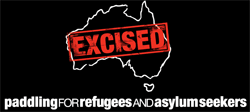
We travelled day and night to get to Townsville to Darwin. If we haven’t said it before, this is a bit country! And it is truly beautiful.
Before we left Darwin, Oxfam and A Just Australia released a report that they had written on Australia’s offshore processing system. I wrote a piece that was published in the Age Online about the report:
At what cost protection?
The waters off Christmas Island are remarkable. Beneath the surface, they are alive with tropical fish and coral. From above, the sea is a blue that is at the same time translucent and deep. It was in these waters, six years ago almost to the day, that the Tampa sailed and sat, waiting to offload its human cargo. It is here that children were not, in fact, thrown overboard. These are waters in which people seeking Australia’s protection have sailed and swum, and in some instances, died. It is not far from here that the SIEV X sunk, with the loss of 353 lives.
These are waters that have been central to Australia’s response to asylum seekers over the past decade or so. They are Australian waters. But this is also part of the ‘excised zone’. Christmas Island was one of the first Australian territories to be removed from the migration zone in order to prevent asylum seekers landing there from being able to make a valid visa application.
Instead, such people can be removed forcibly to places like Nauru and Manus Island – or kept in detention on Christmas Island – where they are processed in a protection determination system that is demonstrably inadequate.
A report released this week by A Just Australia and Oxfam Australia called A Price Too High: The Cost of Australia’s Approach to Asylum Seekers documents in painful detail the cost of Australia’s offshore processing system.
The most devastating costs are, of course, human. According to the report, ‘A central concern with the offshore detention of asylum seekers is the destructive mental and physical effects for people detained over an indefinite period. Many asylum seekers have already been through traumatic experiences, facing human rights violations and, in extreme cases, torture or the death of family members, in their home country or while escaping overseas. Their psychological ill-health can be exacerbated by their placement under mandatory and indefinite detention, according to medical studies.’
There is also considerable evidence that asylum seekers have been returned to persecution and other serious human rights violations. My own research with returned asylum seekers in Afghanistan and Pakistan illustrates this. More recent research conducted by the Edmund Rice Centre found that as many as eight Afghans who had been returned by Australia from Nauru may have been killed. According to the Edmund Rice Centre, three children of an Afghan man denied protection in the Pacific Solution were also killed.
This is hardly surprising. The offshore processing system is designed deliberately to exclude the checks and balances that are built into to the onshore system.
For example, in the onshore system asylum seekers whose cases are rejected by immigration department officials can appeal to the independent Refugee Review Tribunal. Between 2003 and 2006, the RRT overturned 92 per cent of immigration department rejections in cases concerning Iraqis and Afghans – the most prominent nationalities of asylum seekers in the Pacific Solution. 3200 people who might otherwise have been returned to situations of persecution were instead offered protection because of the RRT safety net.
There is no such independent appeals mechanism in the offshore process.
The financial cost of offshore processing is also alarming. A Price Too High shows that at least $1 billion has been spent on offshore processing since 2001. This amounts to half a million dollars to process each of the almost 1700 asylum seekers who have been caught in the system since its inception.
It is not merely the bottom line that is concerning. It is also the allocation of funds. Rather than being focused on the future development of countries like Nauru, aid has been directed towards Australia’s immigration outcomes. Increases in Australia’s Overseas Development Assistance have been ‘directly tied to the Pacific Solution on Nauru,’ the A Just Australia/Oxfam report says. According to a former staff member of the official Australian aid agency, aid payments to Nauru are “an unmitigated bribe” to ensure the continuation of the Pacific Solution.
Offshore processing was a radical development in Australia’s response to asylum seekers. It is also the bastard child of a set of policy assumptions that had been developing since the before the Howard government assumed power. It was Labor that established a system whereby asylum seekers who arrived in the country without prior official authorisation were detained – arbitrarily – well away from the major population centres of Australia. The Howard Government’s offshore processing system has reinforced emphatically this sense of asylum seekers being ‘out of sight and out of mind’. It has also ensured that the government’s actions, to the greatest extent possible, are beyond the scrutiny that is fundamental to accountable government. The failures of the offshore system, according to the authors of A Price to High, ‘ultimately undermine Australians’ ability to be confident that a fair and equitable application of the law will occur in their country; they undermine their ability to be confident that governments can be held accountable for their decisions and they potentially damage social harmony and cohesion.’
Taken together, the costs of offshore processing – particularly for those people caught within it – are far too great. It is time to excise the excision laws and to abandon Australia’s offshore processing system.



















